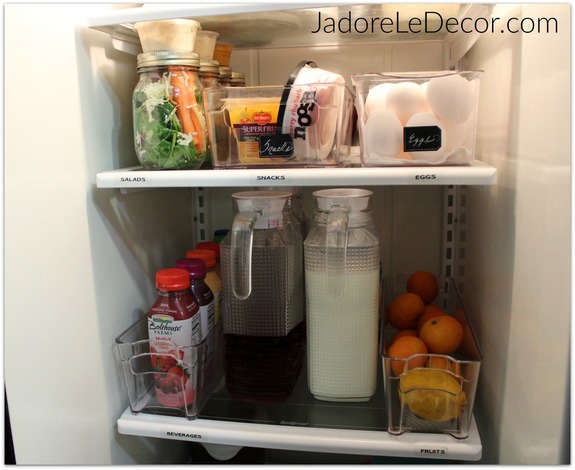Whole House Organization Challenge: Week 4
Welcome to week 4 of the Whole House Organization (WHO) Challenge! We're winding down in the kitchen. Today we're organizing the fridge.
No, it's not the most glamorous thing to write about. But if the kitchen is the hub of a home, then the fridge is the heart of a kitchen. Without this baby, this room is practically useless. So it only makes sense that it should be organized too.
Affiliate links may be included in this post. This means that should you purchase a linked product, I may receive a small commission, but at no additional cost to you. To read my full disclosure click here.
But is the goal to make my refrigerator "Pinterest Perfect"? If you can get it to look that way, and function to fit your needs at the same time - GREAT! My main focus, however is to organize it in a way that allows me to:
- Find what I need
- Assess my needs, so that I'm not buying things I already have, or letting food go to waste.
- Return items to their proper place quickly.
THE PROCESS: Empty, Purge, Sort, Scrub, Analyze, Return
- Empty ALL of the shelves of food
- Purge anything that is expired. Check the expiration dates on EVERY SINGLE item.
- Sort and group items according to their type.
- Scrub the insides of the fridge and freezer with your favorite cleaning solution.
- Analyze your space. Give thought to the best location for things.
- Return the items that are left to the unit
WHAT GOES WHERE?
A. The Inside Door: Butters, condiments, salad dressings, lunch bags, baked goods
The refrigerator door is the warmest part of the fridge. Additionally, the temperature changes every time the door is opened and closed. For these reasons, eggs and milk should never be stored here. Condiments, on the other hand, contain natural preservatives like vinegar and salt, which makes this location perfect for them.
However, different sized jars and bottles can make the fridge appear cluttered. So whenever possible, I transfer my condiments to squeeze bottles. Expiration dates can easily be written on the bottles using chalk board or dry-erase labels.
Arranging your fridge door this way has two benefits: 1) creams, eggs, and milk won't spoil as quickly, and 2) it will preserve your door shelves.
But what if you've already damaged/broken your refrigerator door shelves by loading them with too many things?
TIP: Try Sugru. Sugru is a flexible putty that can be used to repair or protect just about anything. I used it to repair my damaged refrigerator shelves, which in turn, saved me at least $100 or more in replacement costs. I also use it to keep my cell phone cord from fraying. This is real life problem-hacking folks! And this stuff is amazing!
The only con? Once the door shelf is put in place using the Sugru, it will be a permanent fix. So test the configuration to make sure the shelves are spaced adequately.
. The Top Shelf: specialty items
A Lazy Susan helps me to organize specialty items like cherries, sour cream, prunes, relishes, etc. And yes, I eat prunes- but only when they're wrapped in bacon. Ha! It's a wonderful combination. To read about my first experience with bacon-wrapped prunes click here.
C. The Center Shelves: Pre-made salads, snacks, eggs, beverages, fruit, and leftovers
Air flows most evenly in this portion of my fridge. So I store my beverages in inexpensive glass carafes which keeps them cooler than box cartons or plastic. I also use clear, labeled bins to organize the fruits and smaller beverages.
I also prepare salads ahead of time and store them in glass mason jars. I'm sure you've seen this all over Pinterest. It's so convenient when I need to pack my lunch in a hurry. I just grab and go!
My leftovers go on the shelf below this one. I make sure to use square containers whenever possible, to allow more space.
D. The Bottom Drawers: Special garlic spreads, cheese, veggies and herbs
This is the coldest part of my fridge since the cold air enters from bottom. In the first drawer I store special butters, cheese, veggies and herbs. And of course, an enormous tub of chocolate chip cookie dough. Notice that I use containers, inside of the drawer to keep
In the lowest drawer, I store raw meat that I plan to prepare. Keeping it in this drawer means that should the wrapping fail, I won't have meat juice all over the leftovers, fruits and vegetables, and other items. Yulk!
E. The Freezer
I have -hands down- one of the most difficult freezers, in my opinion, to manage. It's a skinny side by side freezer with an enormous ice maker built in. It's so narrow, that despite all my maneuvering, I couldn't get a clear photo of it, so you'll just have to trust me.
Refrigerator bins are not useful here, as it would be next to impossible to slide them in and out with ease. So I designate a shelf for specific items:
Top shelf: Dairy items and quick snacks.
Center Shelf: Fish & Seafood
2nd Center Shelf: Frozen & blanched vegetables
Bottom Shelf: Meat
So there you have it - an organized fridge. Like I said, it's not the most glamorous thing to organize. But getting your fridge in order will absolutely improve the way you operate in your kitchen. Now we can finally check this room off the list!
I purposely moved slowly through this room, so that followers could keep pace with me. The next few rooms will be much easier to organize, which means we'll speed up the pace a bit. Next up is the dining room.
Please tell me in the comments below how you're feeling about this challenge? Did you have any questions? Is there an organization problem that has you stumped?







